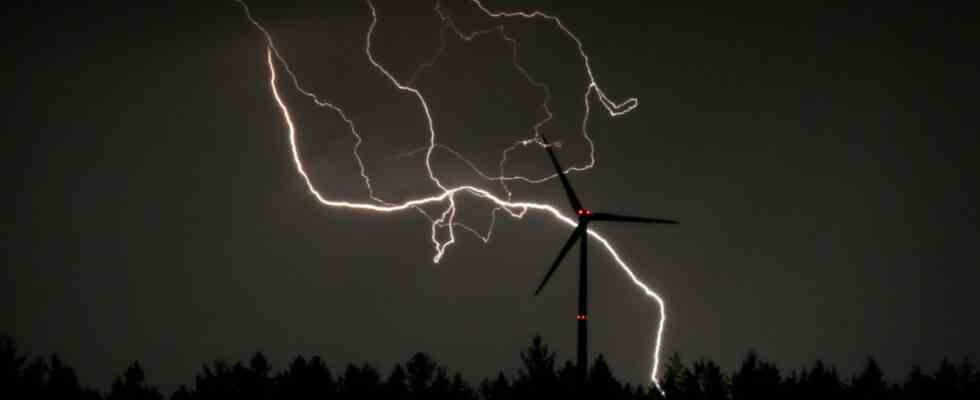Calmness among the free voters, rage among the CSU – there was an astonishing contradiction in the reactions that came from the state government on Wednesday to the wind power initiative of the Green Federal Climate Minister Robert Habeck. Then the draft law from Berlin became public, according to which each federal state is assigned a binding quota for wind turbines. If Bayern meets the goals, the controversial 10-hour distance rule can remain in place. If not, it falls away under federal law, so Habeck would take rigorous action. Basst scho, said Economics Minister Hubert Aiwanger (FW): “We will meet the requirements of the federal government”, the planned relaxation of the 10-H rule in the Free State brings enough potential for wind turbines. On the other hand, building minister Christian Bernreiter (both CSU) answered a question to the state chancellery of Prime Minister Markus Söder quite differently: he called Habeck’s draft “perfidious”, reprimanded a “sanction club” and the “crowbar” principle – the federal government “is using it to put wind power against the People”.
Political banter, you might think at first. Finally, with a view to the 2023 state elections, Söder has given the CSU ministers the task not to miss an opportunity to stir up trouble against the Berlin traffic lights – and Bernreiter, who was appointed in February, recently did so frequently and happily. It is also known that the Lower Bavarian Bernreiter should contest the territory of the Lower Bavarian Aiwanger within the coalition, wherever possible, the partners will be competitors again in 2023. And yet the triangle game Habeck-Aiwanger-Bernreiter on Wednesday raises questions: How is the harmony between the CSU and FW in terms of wind power? And what’s more: What is the real status of the Bavarian energy plans and the federal government’s targets? Easy to implement, as Aiwanger suggests? Or can one interpret Bernreiter’s furor in such a way that it will be difficult if the distance rule is maintained?
The central obstacle to expansion is 10 H
According to the Berlin proposal, which is soon to be decided by the Federal Cabinet, 1.1 percent of the state area must be available for wind power by 2026, and then 1.8 percent by 2032. That is just below the two percent that has mostly been mentioned so far. Currently, just 0.5 percent is earmarked for wind turbine construction in Bavaria, and only 0.2 percent is turning some. The Renewable Energies Association cites another number as evidence of why Bavaria is far behind at the bottom when it comes to wind power. Here there is only one system every 62 square kilometers, in Schleswig-Holstein, which is about as densely populated, there is one for every five square kilometers.
The central obstacle to expansion is 10 H, according to which new wind turbines must be at least ten times their height from the nearest settlement, which is usually two kilometers. The state government wants to allow at least 800 wind turbines with its partly softened rule: a halved distance applies, among other things, in forests, on industrial areas or motorways. When presenting his energy concept in mid-May, Söder was confident that he would achieve the two percent target. There is no guarantee that the Free State will actually and, above all, do so in a timely manner with its new plans. Minister Bernreiter vehemently claims that wind power will be substantially promoted with the state government’s new plans. But experts are – to put it mildly – very skeptical as long as there are no appropriate space specifications. According to the will of the federal government, Söder and the state government must now deliver them – in such a way that the expansion successes can be realistically forecast.
The question of the unity of the CSU and Free Voters on wind power remains. Again, it is helpful to take a look at the two previous parliamentary periods. The FW, above all their chairman Aiwanger, who has been Economics Minister and Deputy Prime Minister since 2018, have never left any doubt that they see wind power as a great opportunity: for the energy transition and climate protection as well as – from an economic point of view – for the municipalities and small and medium-sized businesses in the rural regions. The CSU, on the other hand, after a brief enthusiasm for the energy transition, gave in to regional protests against wind turbines and invented 10 H to make the further expansion of wind power as difficult as possible.
In the meantime, the CSU has been carrying the controversial requirement “for almost ten years like the holy of holies,” says an influential FW man. “And as is the case with sacred cows: It’s incredibly difficult to slaughter them.” Especially since it is now also a green federal minister who demands the slaughter of 10 H from Söder and his CSU through the area target. The Free Voters, on the other hand, can be accused of being so keen on having a say in government that they have so far tolerated the CSU’s anti-wind power course.

